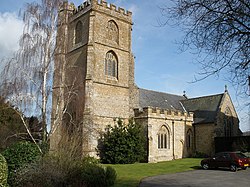Church of St Mary the Virgin, Whitelackington
| Church of St Mary the Virgin | |
|---|---|
 | |
| Location | Whitelackington, Somerset, England |
| Coordinates | 50°56′01″N 2°53′03″W / 50.9335°N 2.8843°W |
| Built | 14th and 15th centuries |
Listed Building – Grade II* | |
| Official name | Church of St Mary the Virgin |
| Designated | 4 February 1958[1] |
| Reference no. | 1057033 |
The Anglican Church of St Mary the Virgin in Whitelackington, Somerset, England was built in the 14th and 15th centuries. It is a Grade II* listed building.[1]
History
[edit]The church was built during the 14th and 15th centuries.[1]
Rev.F.C.Johnson was vicar from 1825-1874.[2]
The parish is part of the benefice of Ilminster and Whitelackington within the Diocese of Bath and Wells.[3]
Architecture
[edit]The hamstone building has slate roofs.[1] The lead of the roof contains images of hands, feet, shoes and names carved into it, the oldest dating back to 1689.[4]
The church consists of a four-bay nave and two-bay chancel which have corner buttresses. The four-stage west tower is also supported by buttresses.[1] The stained glass in the east window is by Charles Eamer Kempe and was installed in 1896.[1]
The interior fittings include a 14th-century piscina in the north transept, and in the east wall there is a richly decorated statue niche. Monuments include two defaced effigies on the floor of the south transept, a civilian of around 1350 and a knight in armour of 1375. The tomb of Sir George Speke is in Perpendicular style.[5] There is also a monument to John Hanning, who died in 1807, which is by J. Richards of Exeter.[1] The Speke family were the lord of the manor and controlled church and village life.[6] Probably the best known is John Hanning Speke.[7]
See also
[edit]References
[edit]- ^ a b c d e f g "Church of St Mary the Virgin". National Heritage List for England. Historic England. Retrieved 2 January 2018.
- ^ Clergy of the Church of England database
- ^ "The Blessed Virgin Mary". A Church Near You. Church of England. Retrieved 2 January 2018.
- ^ "A short history of St Mary's Church Whitelackington". Ilminster Parish Council. Retrieved 2 January 2018.
- ^ "Somerset - 3". Church Monuments Society. Retrieved 2 January 2018.
- ^ Zook, Melinda (2013). Protestantism, Politics, and Women in Britain, 1660-1714. Springer. ISBN 9781137303202.
- ^ Fort, Tom (2012). The A303: Highway to the Sun. Simon and Schuster. ISBN 9780857203274.

